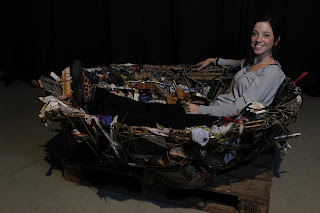Caitlyn Coupe, Semantics Won't Do, Found Object Assemblage, 2010
Issues of place, culture, identity and history are all topics of which can be interpreted differently. The explanation and definition of ones identity is however, a matter of complete subjectivity. The question, ‘Who am I?’ is more often than not, something that most individuals are confronted by. A subject that is of great interest and entirely open to interpretation, became something I decided to further explore.
When engaging with the issue of identity I began to develop a concept, which was suggestive of how people in our contemporary society define themselves and their identity. However, as my concept continued to develop it became evident that I was instead exploring personal ideals and perceptions that consecutively form my own identity. Through challenging obstacles of process engagement and media choice, I have produced a resolved body of work that effectively communicates and relates to myself as an individual; ‘Semantics Won’t Do’.
The work ‘Semantics Won’t Do’ explores themes of identity and possession, reflecting on the way in which people tend to define themselves and their societal position purely on material possession. The sculpture uses multiple layers to juxtapose two ways in which a person defines themselves and their purpose. The use of found objects represents an identity defined by material possession and financial status versus the value of lived experience symbolised by the nest.
In relation to my personal identity, I have used this juxtaposition not only to reiterate what I believe to be important, but also to place emphasis on what I perceive to be irrelevant to who I am as an individual. The nest itself is symbolic of my personal values, priorities, and experience, all of which I feel contribute profoundly to my identity. My values and priorities are based upon the personal relationships I have with the people surrounding me. The nest explores themes of comfort, safety and protection, directly relating to the relationship between my mother and I and represents the permanent bond we share.
While the structure signifies importance, it has been constructed entirely from found objects, representative of material possession. The incorporation of found objects has been used to portray how important I consider objects to be. By creating an assemblage of only destroyed and dysfunctional objects into organised clutter, I am placing emphasis on the insignificance of object ownership.
 |
| Semantics Won't Do (Detail) |
The title ‘Semantics Won’t Do’ makes reference to the dominant reading of the work in comparison to the intended meaning. While each object may be interpreted individually, it is the assemblage and the structure that these objects form which communicates the underlying concept. When viewing and analysing this work it makes a transition from synchronic to diachronic and as a consequence ‘Semantics Won’t Do’ is a narrative artwork. In the same way, Louise Bourgeois’ work, ‘Spider’ is said to deploy a narrative based work by going beyond an anteriority narrative, militating against iconographic translation (Bal, 1999).
‘Semantics Won’t Do’ additionally explores and combines two contrary values by employing visual metaphors which resist the other, while at the same time working together to convey an individual concept. It is a possibility that when taken out of context the found objects may communicate individual meaning. However, when identifying with the multiple layers operating within the work, my values and opinions become evident.
Much like the work ‘Lifespan’ by Claire Healey and Sean Cordeiro, the materials used to construct my artwork are not reminiscent of the structure built (Haly 2009). The different medium instead oppose one another by representing two opposing values (Haly 2009). In accordance with this, Healey and Cordeiro employ found objects within their artwork ‘Deceased Estate’ in order to create a sculptural assemblage, similar to the context and process explored within ‘Semantics Won’t Do’.
 After reflecting on the visual representations within ‘Semantics Won’t Do’ it is apparent that they have been used, not only to suggest that some define themselves materialistically, but also to exemplify my rejection of this characteristic. Through process and conceptual development, the artwork has evolved and fits within the context of a narrative, found object assemblage/sculpture. Overall, through the exploration of identity as a whole, my personal perceptions, values and beliefs have very much defined the conceptual framework of this piece.
After reflecting on the visual representations within ‘Semantics Won’t Do’ it is apparent that they have been used, not only to suggest that some define themselves materialistically, but also to exemplify my rejection of this characteristic. Through process and conceptual development, the artwork has evolved and fits within the context of a narrative, found object assemblage/sculpture. Overall, through the exploration of identity as a whole, my personal perceptions, values and beliefs have very much defined the conceptual framework of this piece.
REFERENCES:
Bal, B. (1999) Narrative Inside Out: Louise Bourgeois’ Spider as Theoretical Object. Oxford University Press, 22(2),123. Retrieved from http://www.jstor.org/stable/1360637
Haly, J. (Art Student). (2009) Venice Bienalle [interview]. Sydney, Aus.: Venice Bienalle Education Team. http://www.bbc.co.uk/bbcfour/audiointerviews/profilepages/craggt2.shtml




















